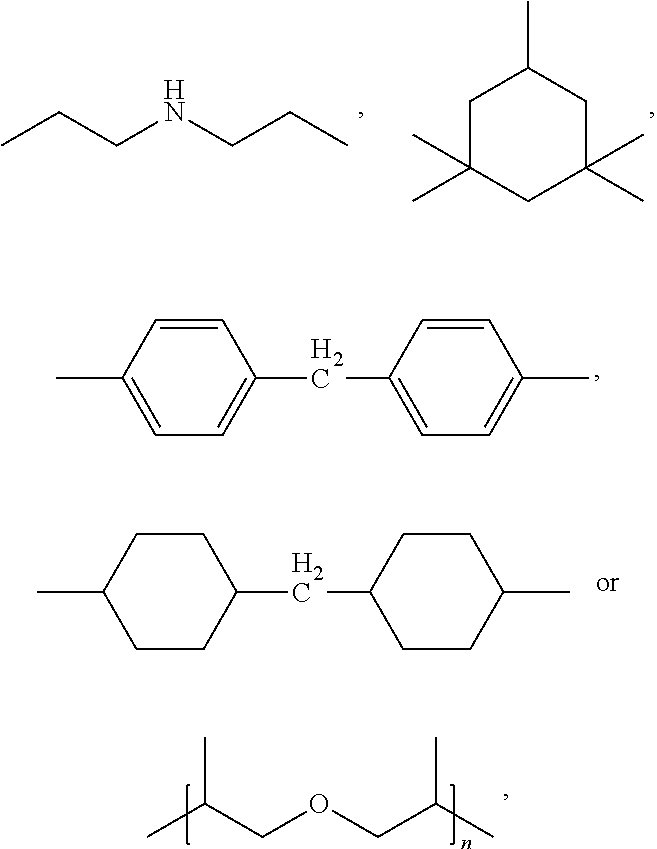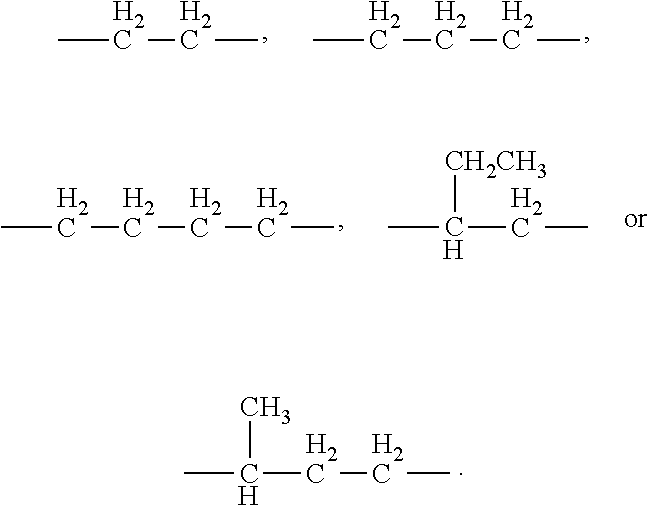Epoxy resin material, preparation method therefor and application thereof
a technology of epoxy resin and resin material, which is applied in the preparation of carboxylic acid nitrile, chemistry apparatus and processes, and organic chemistry, etc., can solve the problems of poor mechanical properties of cured products, inability to prepare large-scale wind power blades, and inability to fully flow in the mold during the preparation of composite materials, etc., to achieve low mixing viscosity, low exotherm, and long operation time
- Summary
- Abstract
- Description
- Claims
- Application Information
AI Technical Summary
Benefits of technology
Problems solved by technology
Method used
Image
Examples
example 1
[0058](1) Preparation of an Adduct of an Olefinic Nitrile Compound and an Amine Compound (Hereinafter Referred to as Adduct)
[0059]① The acrylonitrile was purified by using a rotary evaporator which was vacuumed with a water pump; the vacuum degree was −0.2 Mpa, and the temperature was 45° C.; the fraction having an acrylonitrile content of about 65 wt % was collected;
[0060]② 170 g of IPDA was added into a reactor, the reactor was purged with nitrogen and heated to 55° C.; under the action of 0.085 g triethylamine, 106 g of the fraction obtained from ① was added dropwise into the reactor; after the dropwise addition was completed, the reaction was carried out for 6 h and then the temperature was lowered to room temperature, and the adduct was obtained.
[0061](2) Preparation of Epoxy Resin Material
[0062]Preparation of epoxy resin main agent: 70 g of DER 331 was added into a mixing equipment, and heated to 55° C. and then maintained at the same temperature; 15 g of XY622 and 15 g of BYK...
example 2
[0066](1) Preparation of an Adduct of an Olefinic Nitrile Compound and an Amine Compound (Hereinafter Referred to as Adduct)
[0067]① The acrylonitrile was purified by using a rotary evaporator which was vacuumed with a water pump; the vacuum degree was −0.2 Mpa, and the temperature was 45° C.; the fraction having an acrylonitrile content of about 65 wt % was collected.
[0068]② 170 g of IPDA was added into a reactor, the reactor was purged with nitrogen and heated to 55° C.; in the presence of 0.085 g triethylamine, 106 g of the fraction obtained from ① was added dropwise into the reactor; after the dropwise addition was completed, the reaction was carried out for 6 h and then the temperature was lowered to room temperature, and the adduct was obtained.
[0069](2) Preparation of Epoxy Resin Material
[0070]Preparation of epoxy resin main agent: 70 g of DER 331 was added into a mixing equipment, and heated to 55° C. and then maintained at the same temperature; 15 g of XY622 and 15 g of BYKA...
example 3
[0074](1) Preparation of an Adduct of an Olefinic Nitrile Compound and an Amine Compound (Hereinafter Referred to as Adduct)
[0075]① The 3-butenenitrile was purified by using a rotary evaporator which was vacuumed with a water pump; the vacuum degree was −0.2 Mpa, and the temperature was 45° C.; the fraction having an 3-butenenitrile content of about 65 wt % was collected;
[0076]② 103 g of DETA (diethylenetriamine) was added into a reactor, the reactor was purged with nitrogen and heated to 55° C.; under the catalysis of 0.26 g KOH, 201 g of the fraction obtained from ① was added dropwise into the reactor; after the dropwise addition was completed, the reaction was carried out for 6 h and then the temperature was lowered to room temperature, and the adduct was obtained.
[0077](2) Preparation of Epoxy Resin Material
[0078]The preparation of epoxy resin main agent: 70 g of DER 331 was added into a mixing equipment, and heated to 55° C. and then maintained at the same temperature; 15 g of ...
PUM
| Property | Measurement | Unit |
|---|---|---|
| temperature | aaaaa | aaaaa |
| temperature | aaaaa | aaaaa |
| temperature | aaaaa | aaaaa |
Abstract
Description
Claims
Application Information
 Login to View More
Login to View More - R&D
- Intellectual Property
- Life Sciences
- Materials
- Tech Scout
- Unparalleled Data Quality
- Higher Quality Content
- 60% Fewer Hallucinations
Browse by: Latest US Patents, China's latest patents, Technical Efficacy Thesaurus, Application Domain, Technology Topic, Popular Technical Reports.
© 2025 PatSnap. All rights reserved.Legal|Privacy policy|Modern Slavery Act Transparency Statement|Sitemap|About US| Contact US: help@patsnap.com



